
Secretary
Abraham Gets the ‘Wow’ Tour
Berkeley Lab Wins ‘R&D
100’ Awards for Unique Electrochromic Windows and
Synthetic Nanomotor
Secretary Abraham Gets the ‘Wow’ Tour
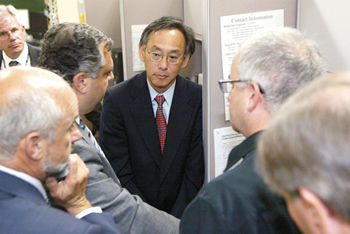 |
|
| Deputy Director Pier Oddone (left), Energy Secretary Spencer Abraham and Berkeley Lab Director-Designate Steven Chu listen intently to an explanation of protein imaging at the Advanced Light Source by Physical Biosciences scientist Gerry McDermott. | |
He showed it in his attention to detail and in his questions during the presentations. He showed it in his wide-eyed observation of demonstrations and new technologies, and in his commitment to support them. Members of his traveling staff were heard to say “that’s cool” and “how about that?” on more than one occasion.
Call it the “wow” tour
Also in attendance was Steven Chu, Berkeley Lab’s Director-to-be who used the occasion to begin his orientation period prior to his official Aug. 1 start. And Otis Port, a reporter for Business Week who is accompanying Abraham on his west coast swing, took copious notes at each stop in the schedule, staying late to talk with executives from several Lab nanotechnology spinoff companies.
Abraham capped it all off with the presentation of a plaque to the Lab for its contribution of the front end — featuring the ion source — for the Spallation Neutron Source in Tennessee, the DOE’s largest-ever facility. Handing the framed tribute to Rick Gough, acting director of the Accelerator and Fusion Research Division, and Rod Keller, senior team leader for the front end project, the Secretary said, “So many times, we see a lack of appreciation of the extent to which we have interaction and collaboration between facilities. The SNS is such an example. It’s such a large project, it doesn’t reflect the role that facilities like this play. But we really appreciate it and thank the people of Berkeley for collaborating in this effort.”
Preceding the Building 50 lobby ceremony were a series of briefings on some of Berkeley Lab’s most promising and decorated projects. Scientific leaders in astrophysics, x-ray spectroscopy, energy efficiency, and nanotechnology each articulated the merits of programs that have or will have made a splash in the world of science. In the absence of Director Charles Shank, Deputy Director Pier Oddone played host to the entourage.
First stop: the universe. Physicists Saul Perlmutter and Michael Levi updated the Secretary on the status of the proposed SuperNova Acceleration Probe (SNAP), a billion-pixel camera and satellite designed to trace the history and development of the universe through in-space observations of exploding stars. The project is proceeding with R&D and is awaiting acceptance within the Joint Dark Energy Mission (JDEM), a collaboration between DOE and NASA.
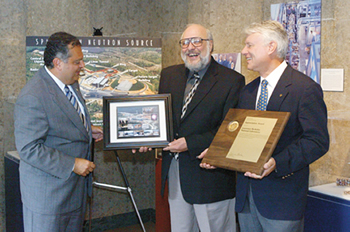 |
|
| Secretary Abraham (left) presented a plaque to the Laboratory for its contribution to the Spallation Neutron Source — the front end. Accepting the plaque are Rick Gough (middle, holding a photo montage of the project), and Rod Keller, senior team leader for the project. | |
“It is our opportunity to answer large philosophical questions of our day — like ‘What’s the universe made of?,’ and ‘Does space go on forever?’”, said Perlmutter. He predicted that, if the funding lines up and timely decisions are made, the probe could launch by 2011. Following the exhibition of several project pieces, the telescope model, and an animated film of the functioning device, Abraham told them, “I’ll make sure we keep it high on their (NASA’s) attention list.”
The group’s experience at the Advanced Light Source was equally eye-opening. With the emphasis on research partnerships with industry, scientists showed how the ALS’ ingenious operation can enable the development of everything from next-generation computer chips to disease-fighting drugs. Senior scientist David Attwood led the presentation on Extreme Ultra-Violet (EUV) lithography and its application to developing tinier, more powerful semiconductors. From a 4-Gigahertz, 65-nanometer size regime today, by 2009 it is expected to go to 19 Gigahertz and 32 nanometers. EUV lithography is the leading technology in the field.
“And this is the forefront place in the world for testing products at this level,” Attwood told the Secretary. “The finest print features are being done here.”
Around to the other side of the ALS ring, Abraham was also shown the imaging of proteins at the Macromolecular Crystallography beamline. Staff scientist Gerry McDermott illustrated the prospect of a leukemia-fighting drug via the characterization of a protein that regulates white blood cell production. And Physical Biosciences Division Director Graham Fleming noted the Lab’s collaboration with the Howard Hughes Medical Institute, whose two beamlines are studying biomedically important molecules as a framework for understanding how molecules function and interact.
The eight beamlines devoted to protein crystallography “make us a real powerhouse in this business,” Oddone told the Secretary after an especially captivating drugs-by-design explanation.
No less impressive was Environmental Energy Technology’s demonstration of dynamic windows that change their tint in response to the light. The windows facility, on a bluff next to Building 71, was the stage for scientist Eleanor Lee’s exhibition of what she called “road testing” of emerging energy-saving windows technologies. “It is our intent to accelerate the development by improving the technologies,” she told Abraham, noting that such “smart” windows still only capture about 1 to 2 percent of the market.
Her presentation was followed by researcher Tom Richardson’s demonstration of unique electrochromic windows, which switch from reflecting to transparent with the flick of a switch. Abraham and others stared at the transition, a six-inch-square glass, and saw the future. At least that’s what Research and Development magazine said — it awarded the technology a prestigious R&D 100 award last week (see “R&D 100” story on page 1).
In its finest “you ain’t seen nothin’ yet” style, the materials sciences team brought in corporate leaders representing companies that emerged from Berkeley Lab research in nanotechnology. Division and Molecular Foundry Director Paul Alivisatos told the Secretary that the combined net worth of such companies is $1.5 billion, and growing.
Alivisatos, Marvin Cohen and Lutgard DeJonghe, took turns describing work that has led to advances in batteries, solar cells, biomedical imaging and labeling, and detectors. Researchers from Nanomix, PolyPlus, and Quantum Dot corporations brought their products and their stories to the table, each one in support of Abraham’s expressed commitment to the field.
“We feel we will really create the premier world centers for this enterprise,” he told them, referring to the five nano-centers that DOE has committed to build, one being the Molecular Foundry under construction at Berkeley Lab. He said his recent nano-summit in Washington was designed “to bring government, private industry, and academia together to discuss possible challenges like policy and ethics, and address them in a way that’s not frantic, but more thoughtful.”
In a day full of “wow’s,” Uli Dahmen, director of the National Center for Electron Microscopy, might have had the best. In showing off the capabilities of his 10 microscopes and their contribution to the nano-field, he pointed out the invention of a functioning nanomotor (another Berkeley Lab R&D 100 winner) which, he said, “is so small it fits on the back of a virus.” And to illustrate the magnifying power of this world-class user facility, he told the Secretary that, in NCEM’s 20 years of existence, “we have analyzed a total of one cubic centimeter of material.”
Next up is the development of the Transmission Electron Achromatic Microscope (TEAM), another five-lab collaboration which Berkeley Lab is leading. That one will allow scientists to go from viewing atom columns to viewing individual atoms, from two-dimensional to 3D images, and from static to real-time observations.
Secretary Abraham noted that one of his biggest challenges is convincing Congress that the investment in science is worth it, and that productivity justifies the funding. “I need to translate it to real-world [applications],” he told them. “I’ve gained a lot of insights (today) that will help me. ”
Berkeley Lab Wins ‘R&D 100’ Awards for Unique Electrochromic Windows and Synthetic Nanomotor
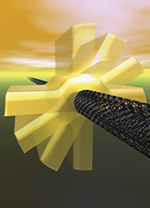 |
|
| Simulation of a nanomotor spinning on a multi-walled carbon nanotube (created by Noah Bodzin) | |
Berkeley Lab scientists have won two of the awards that have been called the “Oscars of Technology.” Alex Zettl, of the Materials Sciences Division, and the team of Tom Richardson and Jonathan Slack of the Environmental Energy Technologies Division, will be honored with R&D 100 Awards, given by R&D Magazine in recognition of the “100 most technologically significant new products and advancements over the past year.”
Zettl won his 2004 R&D 100 Award for creating the smallest synthetic motor ever reported. Richardson and Slack won their award for developing a unique new type of energy-saving electrochromic window. The addition of these two winning technologies brings the total of R&D 100 Awards won by Berkeley Lab researchers to 34.
R&D Magazine began the R&D 100 Awards program in 1963 as a means of identifying technological achievements with the potential to “change people’s lives for the better.” Winners receive a plaque at an annual awards banquet, which will be held this year on October 14 in Chicago, plus a writeup in both the print and online version of R&D Magazine. The winning technologies are chosen from submitted entries by a panel of some 60 independent experts plus the editors of R&D Magazine. Berkeley Lab’s entries were submitted this year through the Lab’s Technology Transfer Department.
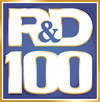 |
|
Zettl’s 2004 R&D 100 award-winning technology is called a “synthetic rotational nanomotor.” The first version of this device consisted of a gold paddle-shaped rotor blade, measuring between 100 and 300 nanometers in length, which was connected to a carbon nanotube shaft less than 10 nanometers thick. Even though this first nanomotor was about 300 times smaller than the diameter of a human hair, the technology behind it allows for future versions to be made even smaller — perhaps as much as five times smaller.
The synthetic rotational nanomotor has been clocked at 33,000 cycles per second and is believed capable of speeds approaching one billion rotations per second. Because the carbon and carbon bonds connecting the rotor blade to the shaft are practically frictionless, the motor can run indefinitely without wearing down. It is also rugged enough to withstand the harshest of environmental conditions, including extreme temperatures and radiation.
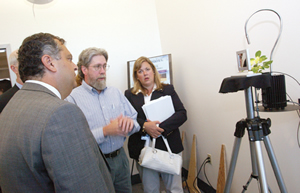 |
|
| Tom Richardson of EETD (middle), one of the winners of the R&D 100 Awards, demonstrates his award-winning transition-metal switchable mirror to Energy Secretary Spencer Abraham (left). Katie Packer of the Secretary's office is on the right. | |
Potential applications of the synthetic rotational nanomotor technology include bio and environmental sensors, cell phones, PDAs, optics, airbags, tire sensors, digital pens, blood pressure monitors, extremely “smart” sub-woofers, and antenna alignment. The technology should also find a broad range of applications in the field of cosmology for the exploration of deep space.
The award-winning technology developed by the EETD team of Richardson and Slack is called “transition metal switchable mirrors.” With this technology, an ordinary glass surface can be coated with a thin film made from an alloy of magnesium and one or more transition metals, such as nickel or manganese. This transition metal film enables the glass to be reversibly converted from a reflecting to a transparent surface through either an electrical charge or exposure to hydrogen gas. As the film can be programmed to respond to sunlight passing through a glass window, its wide use represents enormous potential savings in energy and money each year. Heating and cooling energy lost through windows are estimated to annually cost U.S. consumers about $9.3 billion.
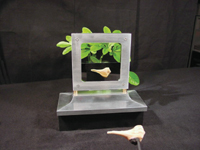 |
|
| Transition-metal switchable mirror windows vary from transparency to heat and light, such as the top half of this sample, to being almost wholly reflective (bottom). | |
The technology behind the electrochromic windows on the market today relies on thin films fabricated from earth metals. By making their thin films from transition metals instead, Richardson and Slack were able to significantly lower the costs of the windows, as well as add to them the capability of reflecting and absorbing both visible and infrared light.
Among the possible applications of this technology, in addition to glass windows in buildings, are sunroofs and space missions. Already, Richardson and Slack are working with two major window companies to get transition metal switchable mirrors to the marketplace.
Employees Use Their Cars for Bumper Crop of Messages
 |
| Freedom of speech — it’s the foundation on which our country was born, and one of the most cherished rights of those living here. Which is why bumper stickers are such an important part of our social fabric. They may seem like mere pieces of adhesive-backed plastic slapped on the caboose of a car, but they provide individuals with the power to quietly yet boldly share their thoughts and feelings with the masses. Many employees at the Lab have embraced this method of mobile expression, as evidenced by the wide variety of bumper stickers that appear on cars around the Hill. Here is a sampling of messages from your coworkers — from humor and politics to sports and travel. And for those unfamiliar with the Latvian language, “Sveiks” means “hello.” |
First Day of Summer: Hot Rods and Rock ‘n’ Roll
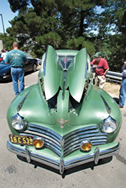 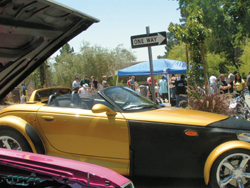 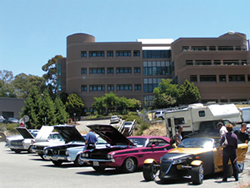 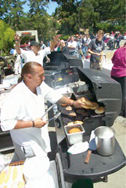 |
| For the third consecutive year, Berkeley Lab threw a bash and classic car show on Friday, June 18 to usher in the summer solstice with a stroll down memory lane. The lunchtime celebration in front of the cafeteria featured a dazzling display of colorful historic rods and coupes owned by Lab employees, as well as a barbecue picnic and 1950s hits courtesy of the Lab’s Music Club. |
Environment-Friendly Ethanol Debuts at Berkeley Lab
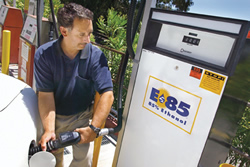 |
|
| Don Prestella is fueling one of the Lab vehicles with E-85. | |
“By the end of this year, our flex-fuel fleet — those that are capable of using unleaded fuel and/or ethanol 85 — will grow to about 75,” said Don Prestella, the Lab’s fleet supervisor. “It is our goal to run all of them exclusively on ethanol.” The total fleet numbers around 250 vehicles.
“E-85” is a blend of 85 percent ethanol, a renewable biofuel called ethyl alcohol made from grain like corn, and 15 percent gasoline. Converting grain to ethanol helps offset carbon emissions from fossil fuels, and vehicles that use it produce 25 percent less carbon monoxide and nitrogen oxide emissions.
Berkeley Lab has become one of about 150 E-85 fueling stations now in operation in more than 20 states. The transition means that the Laboratory will be able to meet its alternative-fuel target for reduced air emissions established in 1999 by executive order for all federal facilities.
This might seem like a drop in the fuel bucket, but the trend toward such alternatives is up. Just over 5 million acres of corn are currently used to produce ethanol each year, and experts see that doubling in the next few years. More than 3 million flexible fuel cars are on the roads today. “Within the next five years, [ethanol] will be everywhere,” Prestella predicts.
Ethanol is the most widely used alternative fuel. Berkeley Lab gets its supply from a producer in Idaho, according to Prestella.
The renewable fuels association also notes that ethanol contains 35 percent oxygen, and adding oxygen to fuel results in more complete fuel combustion, thus reducing tailpipe emissions. Ethanol also displaces the use of toxic gasoline components such as benzene — and it is non-toxic, water soluble, and biodegradable. It reduces greenhouse gas emissions (compared to conventional gasoline) by 12 to 19 percent, tailpipe carbon monoxide by up to 30 percent, and exhaust VOC emissions by 12 percent.
Much of the Laboratory’s vehicle conversion was made possible by an $83,000 grant from the Department of Energy. A new vapor recovery system on the Ethanol storage tank — the first in California — has been approved for three-year testing by the state Air Resources Board.
The Lab also uses bio-diesel in all of its diesel vehicles, including buses.
Building Blocks for Biobots
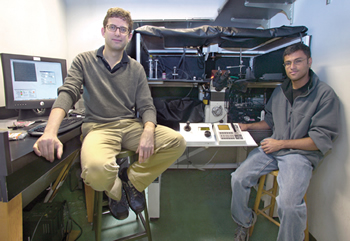 |
|
| Jan Liphardt (left) and graduate student Hari Shroff have used an instrument that combines magnetic tweezers with single-molecule fluorescense detection to characterize nanoscale strain gauges for measuring biologically-based nanostructures. | |
Leading that transition is the nation’s first Synthetic Biology Department, headed by PBD scientist and UC professor of chemical engineering Jay Keasling. As founding members of the new department, Liphardt and his group are particularly interested in what Carlos Bustamante, a PBD scientist and UC professor of biology, physics, and chemistry, has dubbed “biobots” — special-purpose robots — part biological, part artificial, and no bigger than a cell or virus.
What to do with a biobot
Biobots have potential for medicine, national security, environmental protection, and many other fields. As one example, Liphardt envisions biobots designed to decontaminate toxic spills: “They could detect and identify specific hazardous chemicals, track down the extent of contamination, and internally manufacture whatever was needed to clean up the mess — all with one trip to the site.”
Simpler and less versatile than highly evolved living systems, biobots will nevertheless mimic nature in important ways. For example, once the component parts are provided they’ll assemble themselves.
“Outwardly they’ll consist of enclosures resembling cell walls or viral capsids,” Liphardt says. “Molecular motors like flagella will give them motility.” A set of modules will provide power from light or chemicals to make ATP, the molecules cells use to store and transport energy, and for sensing their environment and performing specialized tasks — in sum, says Liphardt, “a collection of functional and structural LEGO blocks that we can mix and match.”
An early lesson of synthetic biology research is that living organisms produce an amazing diversity of materials, ranging from nanoparticles of silver, made by some bacteria, to single-mode optical fibers. Researchers at Bell Labs recently discovered that the deep sea sponge Euplectella grows spine-like structures that function as optical fibers — having excellent optical properties and better crack resistance than conventional artificial fibers.
A biobotic tool kit
Liphardt compares the first biobot to the Wright brother’s first powered airplane: “The Wrights didn’t have to reproduce the flight of birds in all its details,” he says, but it was important “to know that it could be done.” His group is busy assembling the special tools they’ll need to do it.
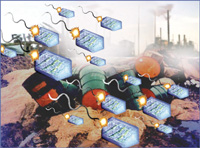 |
|
| Among the many possible applications of tailor-made biobots are toxic-spill clean-ups. The ‘bots might detect and analyze a variety of toxins, determine the extent of contamination, and manufacture chemical cleaners. | |
“The established tools are optical tweezers, magnetic tweezers, and atomic force microscopes,” Liphardt says, “but typically they are not used simultaneously.” Combining imaging and manipulation is an urgent priority. “Imagine trying to build a steel building and having to choose between moving the girders around but not knowing precisely where they are — or knowing exactly where they are but not being able to grab them.”
In FRET, fluorescence resonance energy transfer, a molecule of fluorescent dye excited by incident light transfers its increased energy to an adjacent dye molecule; fluorescence decreases in the first molecule and increases in the second, a measure of the distance between them.
Dyes can be designed or chosen to bind at specific sites on target
molecules, making it possible to measure the forces involved in
manipulating biological molecules or watch the mechanical-chemical
processes inside living cells through changes in color or brightness.
Liphardt’s group has recently built a combined optical tweezers
and single-molecule fluorescence instrument used to characterize
nanoscale strain gauges for measuring displacements and forces
inside molecular machines.
Thermodynamics on the nanoscale
Beyond the practical problems of assembly lie daunting theoretical difficulties. “Our intuition fails when applied to very small systems,” Liphardt says, because bulk statistics don’t work on the nano-scale. “Imagine a world where your car moves forward only on average, but every once in a while jumps backwards!”
With Bustamante and other colleagues, Liphardt has performed pioneering experiments on the mechanical unfolding of RNA molecules and the forces on microspheres driven through water. The work applies to how energy states govern the folding of large biological molecules and how thermodynamic information about nanoscale systems, previously thought inaccessible, can be recovered. These experiments have extended thermodynamics into the realm of living things — including biobots.
With theoretical tools and mechanical and optical intruments well underway, “next is building an actual device,” Liphardt says. “Only by doing it the hard way can we show we’re on the right track.”
The Wright brothers’ first airplane didn’t carry freight or passengers, and the very first biobot may not do much more than move and respond to its surroundings. Nevertheless, says Liphardt, “Our biobot program is helping to lay the foundations of a future science of molecular architecture. We’re all going to be surprised at the remarkable developments just around the corner.”
DNA’s Grand Prix
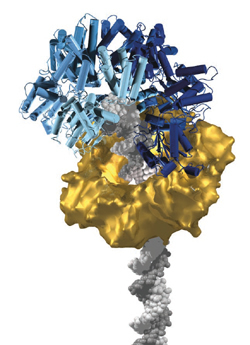 |
|
| Acrobatics during DNA replication: the clamp-loader (blue) bound to the clamp (gold ring), with double-stranded DNA modeled through the clamp and against the underside of the clamp-loader. | |
Such are the acrobatics performed by protein structures during DNA replication. Hoping to shed light on this poorly understood process, a team led by John Kuriyan of the Physical Biosciences Division has captured a split-second glimpse of a speedy protein complex that plays an essential role in DNA’s ability to make copies of itself.
Their work, reported in the June 17 edition of Nature, reveals for the first time how a ring-shaped protein called a sliding clamp may target a special DNA structure generated during replication, in which a polymerase enzyme adds free nucleotides to a single DNA strand. As part of this process, the polymerase uses the sliding clamp like a seatbelt to tether itself to the new DNA double helix.
This protein assembly churns through 1,000 base pairs per second, moving 30 times its length every second. At a human scale, that’s the equivalent of racing at almost one-half the speed of sound. But the protein complex doesn’t just race. It also rotates 100 times per second as it follows DNA’s spirals. And further complicating matters, the polymerase moves in only one direction while the two DNA strands to be replicated are arranged in opposite directions. This means that while one DNA strand can be smoothly replicated by the polymerase, the other strand can only be duplicated in many shorter stretches, with a second polymerase hopping from one piece to another, and its sliding clamp continuously clamping and unclamping from DNA like an automated claw on an assembly line.
“The complexity of its speed and movement is mind-boggling,” says Kuriyan, also a Howard Hughes Medical Institute investigator and a Chancellor’s Professor in UC Berkeley’s departments of molecular and cell biology and chemistry. He conducted the research with fellow Physical Biosciences Division researcher Gregory Bowman and Rockefeller University’s Mike O’Donnell. “But nature is very smart and its solutions are tremendously simple.”
To determine how the sliding clamp targets DNA that is ready to replicate itself, encircles it, then lets go when the replication is complete — all in the blink of an eye — Kuriyan’s group turned to Berkeley Lab’s Advanced Light Source. There, with the help of Physical Bioscience’s Corie Ralston and Gerry McDermott, they used X-ray diffraction to reveal the structure of a sliding clamp from a yeast species as it’s bound to a clamp loader (a five-subunit protein motor that both opens and closes the clamp) and targets it toward freshly unwound DNA strands that are ready for replication. The researchers were able to capture this protein assembly precisely when the clamp loader is poised to release the sliding clamp around its target DNA.
The result is a three-dimensional protein structure that reveals how the clamp loader simultaneously binds to the clamp and ATP, a high-energy molecule that fuels the motor. And from this structure, coupled with a battery of experiments from post-doctoral fellows Marjeta Podobnik, Steven Kazmirski and Eric Goedken, Kuriyan’s group can begin to understand how the protein assembly recognizes DNA strands that are ready for replication — a fundamental process that is conserved in every branch of life.
“The clamp loader recognizes the junction where DNA changes from double strand to single strand,” says Kuriyan. “And it couples this recognition with a structure that forces the clamp loader to release the clamp around DNA.”
This work marks yet another research milestone in Kuriyan’s group, which was the first to solve the structure of the clamp protein more than a decade ago. Next, to gain a more global understanding of how clamp loading works, Kuriyan hopes to determine how the entire protein assembly is configured on DNA.
“Our ultimate goal is to determine the structure of the entire replication assembly at this level of atomic detail,” says Kuriyan. “While it may take us a while to accomplish that task, we are excited about this first structure of a DNA-clamp loader complex in action, which we resolved using X-ray crystallography.”
Summer Lectures Series
Blasting Rocks and Exploring Cells
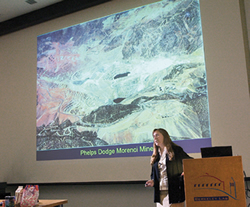 |
|
| Deb Hopkins | |
“We work in a very different way than a lot of scientists do,” said Deb Hopkins at last Wednesday’s noon summer lecture. “Most scientists specialize and become experts in a field. Instead, when you conduct inter-disciplinary work, you do the opposite.”
Things got a bit smaller this Wednesday as Carolyn Larabell, a cell biologist and microscopist in the Physical Biosciences Division, discussed her work peering inside cells a variety of state-of-the-art imaging techniques.
Her main targets are the proteins inside living cells and the things they do. To image these proteins and their activities, Larabell has mastered both electron and confocal microscopy and is blazing new trails with the x-ray microscope, XM-1, at Berkeley Lab’s Advanced Light Source.
“I’m a cell biologist, so I like to look at cells using microscopes of all kinds. No single imaging technique can answer all of the questions,” said Larabell. “Together, these imaging techniques enable the collection of spatial and temporal information.”
Don’t miss the final summer lecture next Wednesday as Jim McMahon of the Environmental Energy Technologies Division discusses his work improving the efficiency of energy and water use.
Giving Them Something to Talk About
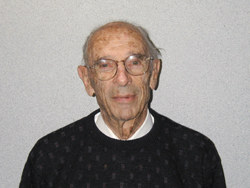 |
|
| At 91, Heinz Heinemann still conducts his seminars on Lab science in Washington D.C. | |
“Our audience started out primarily for U.S. Department of Energy (DOE) personnel, but it has expanded over the years so that we now draw attendees from about 25 different federal agencies,” Heinemann says. “The goal, however, has remained the same — to discuss the science and engineering that takes place at the Laboratory.”
Heinemann was born in Berlin, Germany in 1913 and came to the United States in 1938. He joined Berkeley Lab in 1978, after 40 years of working in the petroleum industry, including the last 10 years with the Mobil Research and Development Corporation. There, among other achievements, he and his colleagues developed a process for converting methanol to gasoline.
During nearly 15 years of active research at the Lab, Heinemann investigated questions about coal gasification, catalytic coal liquefaction, hydro denitrification, nitrogen oxide emission control, and other fossil-fuel related issues. His research won Heinemann one of DOE’s top scientific honors, the 1994 Homer H. Lowry Award in Fossil Energy.
“In 1995, I had just remarried and told Director Chuck Shank that I would be joining my new wife, Barbara, in Washington, D.C., where she held a position at the Library of Congress. He asked me if I would be willing to donate time to the Laboratory’s Washington office.”
Heinemann agreed and, after surveying the situation, decided that the best way he could contribute would be to organize the science and technology seminars.
“I found that there seemed to be a large number of individuals in the federal government who were very much interested in science but knew little about Lawrence Berkeley National Laboratory,” he said.
He began making phone calls and, on June 22, 1995, Alex Bell of the Chemical Sciences Division gave the first seminar entitled “Enhancing the Durability of Automotive Emission Control Catalysts.” Since then, there have been some 90 seminars given by the likes of Glenn Seaborg, Sally Benson, John Clarke, Alex Pines, Mina Bissell, and many others.
“I have tried to be very broad in selecting topics and have looked for research that is relatively easy to explain to non-experts,” Heinemann says.
In recent years, because he has been away from Berkeley for so long, he has received help in selecting topics and speakers from Rob Johnson, who heads Berkeley Lab’s Washington, D.C. Projects Office.
Heinemann’s science and technology seminars are usually held once a month, except during the summer, in the Projects Office, which is near DOE’s Forrestal Building headquarters. Attendance, which is drawn from an invitational mailing list of nearly 300 names, ranges between 25 to 60 people, depending on the topic. Heinemann chairs the talks which start at 9 a.m.
For his efforts, Heinemann takes no salary. To keep travel costs down, the talks are piggybacked on a speaker’s plans to be in Washington, D.C. on other business.
“I think the speakers have considered it an honor to give a seminar here in Washington, because we do have an audience of VIPs, and the talks generate lots of discussion,” he says.
Heinemann and the Lab plan to continue the Washington science and technology seminars with a series of talks in subject areas especially relevant to the national research and development scene. For example, NERSC Director Horst Simon has proposed an upcoming series on supercomputing.
Lab scientists interested in giving a talk at a future seminar may contact either Heinemann at HHeinemann@lbl.gov or Johnson at RKJohnson@lbl.gov .
Mina Bissell Honored in Televised Ceremony
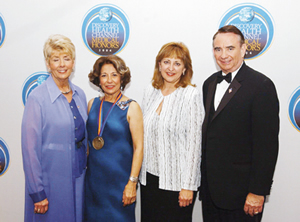 |
|
| Mina Bissell (second from the left) at the Discovery Health Channel Medical Honors ceremony with (from left) Sue Ann Thompson, wife of Tommy Thompson, secretary of Health and Human Services; Susan Braun of the Susan G. Komen Breast Cancer Foundation; and Secretary Thompson. | |
Mina Bissell, holder of a Berkeley Lab distinguished scientist title, has been feted at many award presentations during her brilliant career, but none with the glitz and glamour surrounding the inaugural Discovery Health Channel Medical Honors. Hosted by the famous TV personality Regis Philbin and attended by a galaxy of stars from the entertainment, political and scientific arenas, the awards presentation was the first-ever televised ceremony to celebrate achievements in health and medical science. The presentation, which was held at DAR Constitution Hall in Washington, D.C. on June 23, was broadcast by the Discovery Health Channel (DHC) on July 8.
Bissell, the former director of the Life Sciences Division, has been with Berkeley Lab since 1972 and is a past winner of an E.O. Lawrence Award. She was honored by the DHC for her pioneering research into breast cancer, which revealed that what transpires inside a living cell is greatly influenced by the area immediately outside it. This area, called the extracellular matrix or ECM, is a support network of fibrous and globular proteins. As Bissell has proven, the ECM plays a dynamic role in breast cell growth and development, as well as in the onset of malignancies and other diseases.
“Even though the DHC awards ceremony was very flashy, like a Hollywood event, I have been told by those who attended that it was still a very moving experience,” said Bissell, who received her award — a large silver medallion — from Tommy Thompson, the secretary of Health and Human Services. This was especially poignant as Secretary Thompson’s wife and daughter are both breast cancer survivors.
“He shook my hand and said that he and his family are so proud of my research,” Bissell said.
Bissell was nominated for the DHC Medical Honor by the Susan G. Komen Breast Cancer Foundation, the nation’s leading private source of funding for breast cancer research, which, last December, awarded her their prestigious Brinker Award for Scientific Distinction.
In all, the DHC recognized 13 individuals for their “outstanding contributions to the research and treatment of specific health problems.” The award was sponsored by the DHC in association with the National Health Museum, in partnership with 11 of the country’s preeminent health organizations. Its 13 inaugural recipients were featured in the July 5, 2004 issue of U.S. News and World Report.
As for meeting Philbin, who is known for rapid-wire wisecracks, Bissell has this to say: “He was quite articulate and not at all rude or trying to make jokes.”
Flea Market
- AUTOS & SUPPLIES
- ‘03 TOYOTA PRIUS, 8K mi, white, cruise, CD, side airbags, exc cond, $20,500/bo, Ben, X7725, 530-8703
- ‘99 VW PASSAT V6, 5 spd man, 55K mi, orig owner, drk blue/grey, exc cond, clean title, photos @ http://f2.pg.photos.yahoo.com/ ph/stone.rm/lst?.dir=/4911, $9,900, Tavia, X2534, (415) 519-9956
- MOTORCYCLES
- ‘02 Ducati 620ie, yellow, color version, perfect city bike, beautiful, not stripped, dual fr brakes, rubberized pegs, fairing, rear seat cowling, 5K mi, $4,950, Robert, 304-3711
- HOUSING
- BERKELEY, northside eleg furn apt, 1 bl to UC, DSL & other util incl, Paul X7363, Jin, 845-5959, jin.young@juno.com
- BERKELEY, rm for rent in family home, Ashby & Sacramento, $27 per night incl dinner, Julie, 644-2695
- CENTRAL BERKELEY, 2 bdrm/1 bth, furn house, across street from N. Berkeley BART, fully furn, dishes, linens, 1 bdrm w/ king sz bed, 1 bdrm as office, w/d, avail 8/1– 5/1/05 or longer, $1,750 per mo, Helen, 848-6385, BandB@brownshingle.com
- KENSINGTON, fully furn 3 bdrm home, view, quiet setting, 1 cat, avail for vis scientist during summer and/or fall terms, $1,600/ mo + sec dep, Ruth, 526-6730
- KENSINGTON-BERKELEY border, furn rm w/ sep ent, 2 bl off Arlington Blvd, nr UC/pub trans, sunny, garden view, share bth/laundry & kitchen w/ 2 persons, no smoking, pets neg, lge fenced yrd, $500+ util, 1st & last + $200 dep, Lillian, 525-0209
- NORTH BERKELEY, bed & breakfast, incl breakfast, 1 pers/room, $750/mo or $325/ wk, nr UCB & Lab shuttle, TV, refrig, extra bike, small cottage, $650/mo, Helen, 527-3252
- HOUSING WANTED
- VISITING PROFESSOR/scientist and family from Europe seeks furn house/apt, 2+ bdrm for 11/2004 – 2/2005, alonso@inf . ethz.ch or stefanie.hellweg@chem.ethz.ch
- VISITING SCHOLAR seeks furn or unfurn apt/house, 1 bdrm, liv rm, kitchen, needed for 6 mo to 1 yr starting 9/17-20/04, pref close to UC, KimaniS@aol.com
- MISC ITEMS FOR SALE
- COFFEE TABLE, oak, chest of drawers, Andria, 704-1441
- REFRIGERATOR, Whirlpool, 19.2 cu ft, 10 yo, clean, looks good, works fine, $75, you move it, Matt, X6428
- WANTED
- HOUSESIT, 8/04, mature, responsible, pet care ok, East Bay location, 1 wk minimum, Steve, X6941, 649-9504
- INFORMATION, retired lab employee seeks info/referral from others who’ve had bunion surgery, podiatrist/orthopedist referral appreciated, Rochelle, 883-0161
- VACATION
- LAKE TAHOE house, 3 bdrm/2.5 bth, fenced yrd, quiet sunny location, great views, $195/night, 2 night min, Bob, (925) 376-2211
Honoring Outstanding Performance
In the last issue of the View we pictured eight of the winners of the Lab’s Outstanding Performance Awards who attended a reception hosted by Deputy Director for Operations Sally Benson on June 15. The eight honorees for the month of April 2004, however, were only a small fraction of the total number of recipients — 68 employees — who were recognized with OPAs. Below is the full list, which includes both individual and group awards.
| Paul M. Blodgett | EHS |
| Michael A. Chartock | LD |
| Helena Cheng | BSD/CFO |
| Angela Dawn | BSD/HR |
| Martina Descovich | NS |
| Jamie L. Eberling | LS |
| James G. Floyd | EHS |
| Alyce P. Herrera | BSD/LD |
| James M. Holton | PB |
| Keith R. Jackson | CRD |
| Greg M. Kurtzer | ITSD |
| Anthony M. Linard | LS |
| Anthony H. Lincoln | ITSD |
| Michele M. Mock | BSD |
| Larry R. Myer | ES |
| Cornelia A. Myers | LS |
| Sally F. Nasman | BSD/MS |
| Mary A. Piette | EETD |
| Corie Ralston | PB |
| Mark Regis | EG |
| David E. Skinner | NERSC |
| Neville V. Smith | ALS |
| Robert G. Stokstad | NS |
| Betty L. Strausbaugh | BSD |
| TEAM AWARDS | |
| ASD Academy | |
| Karen B. Ramorino | BSD |
| Suzanne S. Bowen | BSD |
| Linda J. Matyas | BSD |
| Building 51 Lead Project | |
| Gale E. Moline | EHS |
| Mark T. Lasartemay | EHS |
| BLIS Team | |
| Diana L. Brown | ITSD |
| Charles A. Axthelm | BSD |
| Robert Stetson Macfarlane III | ITSD |
| Vik Bhatia | ITSD |
| Vickie W. Ng | ITSD |
| Dale Federighi | ITSD |
| Chun Sheng Li | ITSD |
| Thanasis Bothos | ITSD |
| Anthony H. Lincoln | ITSD |
| Mary M. Clary | BSD |
| Dan Klinedinst | ITSD |
| BRO Team | |
| Vern E. Paxson | CRD |
| Deborah A. Agarwal | CRD |
| EETD Proposals/Finance Group | |
| Garth E. Burns | BSD/EETD |
| Deborah J. Connell | BSD/EETD |
| Rosa Rodriquez-Flores | BSD/EETD |
| HERL Legacy Task Force | |
| Ilham AlMahamid | EHS |
| Dawn D. Banghart | EHS |
| Maram M. Kassis | EHS |
| Wayne W. Lukens, Jr. | CH |
| John J. Seabury | EHS |
| John A. Van Wart | EHS |
| Hipple/Greenway Team | |
| Ralph R. Hipple | EG |
| Wayne G. Greenway | EG |
| Mass Storage | |
| Harvard H. Holmes | NERSC |
| Wayne E. Hurlbert | NERSC |
| Physical Biosciences Safety Management Team | |
| Jeffrey G. Pelton | PB |
| Jack J. Salazar | EHS |
| PyGlobus/PyGridWare | |
| Matt Rodriguez | CRD |
| Monte Goode | CRD |
| David W. Robertson | CRD |
| Joshua Boverhof | CRD |
| Superconducting Magnet Program | |
| Paul A. Bish | EG |
| Nathaniel Liggins | EG |
| James H. Swanson | EG |
| William G. Lau | EG |
| Hugh C. Higley | EG |
| Charles R. Hannaford | EG |
People, AWARDS & HONORS
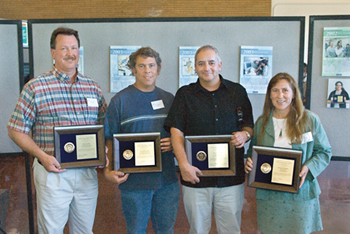 |
|
| From Left: Steve Gourlay, Darryl Dickerhoff, Gerry McDermott and Deb Hopkins | |
Four Lab scientists have been selected as Department of Energy “Outstanding Mentors” for the year 2003. Darryl Dickerhoff of EETD, Steve Gourlay of AFRD, Deb Hopkins of Engineering, and Gerry McDermott of Physical Biosciences were honored at a special event on June 25. The honorees were selected based on how long they have been mentoring, their contribution to DOE and Lab educational goals, and their contribution to encouraging student professional and academic success.
Roe Named Staff Committee Chair
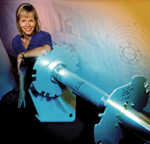 |
|
Natalie Roe of the Physics Division has been appointed by Lab Director Charles Shank as the new chair of the Laboratory Staff Committee. She replaces Robert Stokstad of Nuclear Sciences, who served in the position since 1998. Roe came to the Lab as a postdoc in 1989 and was one of the early leaders in the design of the silicon vertex detector, as well as co-manager of the BaBar collaboration for five years. The staff committee advises the Director on matters concerning science and engineering staff quality and reviews S&E employment actions.
Campbell Named Pinole ‘Citizen of the Year’
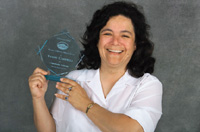 |
|
The city of Pinole, Calif., honored Tammy Campbell for her many years of service and community participation by naming her “Citizen of the Year.” Campbell, who works for the Lab’s Information Technologies and Services Division, is a seven-year resident of Pinole and has been active in her community for nearly two decades. Her involvement ranges from sports activities to advocacy for education and political measures. Her accomplishments include helping found Pinole CARE, an organization that seeks to improve parent and community participation in the town’s education system; helping pass ballot measures that provide funds for the rebuilding of the town’s elementary and middle schools; and helping reinstate the city’s utility users tax, which allowed the town to hire more police officers and firemen. Campbell is a member of the Pinole Valley High School Boosters Club.